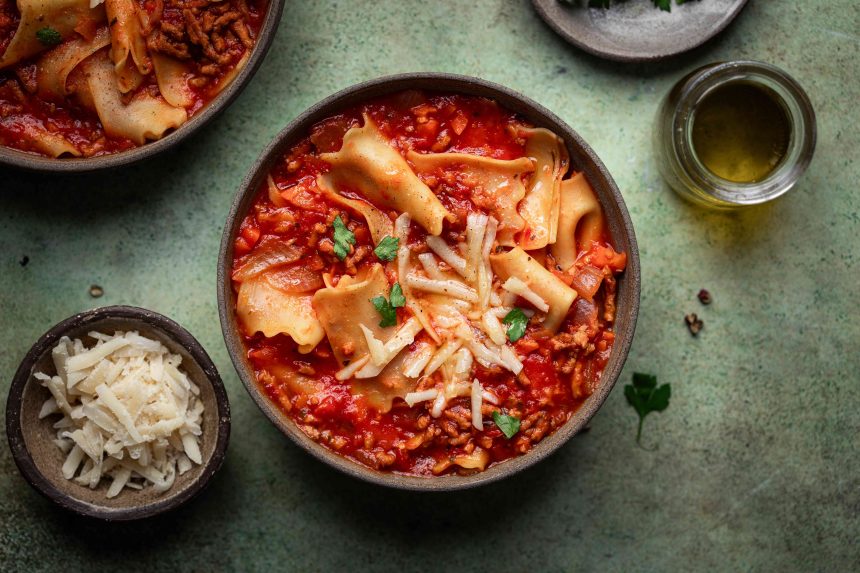If you ask us, every season is soup season (we’re looking at you, gazpacho), but it really does hit the spot during the coldest months of the year. Whether you’ve been shoveling snow or simply relaxing by the fireplace with a good book, the answer to the ever-present “what’s for dinner?” will often be soup.
Lasagna soup offers all of the flavor and comfort of another popular cold-weather dish–lasagna–without the hassle of layering (and waiting for what feels like an eternity for it to bake). This dish really checks all the boxes: it’s a one-pot dinner that comes together quickly with minimal cleanup, is family-friendly, and makes great leftovers. Not to mention, it’s incredibly versatile. Below, you’ll find a pretty straightforward guide for how to make lasagna soup, along with tips on how to branch out and make it a recipe that you will revisit year after year.
What Is Lasagna Soup?
Lasagna soup is, well, exactly what it sounds like! Everything you know and love about a thick slice of lasagna can be found in this brothy one-pot soup. All the elements from the well-balanced tomato sauce and ricotta cheese to the chewy noodles and meaty sausage are there. While lasagna is an Italian-American classic, lasagna soup is a newer favorite. Folks started going crazy for it after Campell’s Soup published a recipe over a decade ago.
Essentially, lasagna soup is made much like any other soup. Italian sausage and aromatics like onions, garlic, and spices are sautéed and simmered with tomatoes, broth, and broken lasagna noodles. The noodles cook in the same pot, soaking up some of the liquid and thickening the soup a little.
Ingredients for Lasagna Soup
Most of the same ingredients used in lasagna are incorporated into this soup.
- Italian sausage: Whether you choose sweet or spicy, sausage is a smart way to add an immediate layer of flavor to soup. It also has more flavor than using ground meat.
- Aromatics: Onion and garlic are must-haves, but a bulb of cored and diced fennel is a nice addition—and it drives home the Italian flavors.
- Seasonings: Store-bought Italian seasoning is not an ingredient we often call for but it’s just right here—and can be used for other dishes like meatballs and Bolognese.
- Canned tomatoes: You can use puréed or crushed tomatoes or try our favorite trick: If you have diced or whole peeled tomatoes, use an immersion blender to break them up a bit.
- Broth: Chicken or vegetable broth work for lasagna soup. Even water will do—just add a few bouillon cubes if you have them.
- Lasagna noodles: Break up whole noodles into three or four pieces each before adding to the soup. You don’t need to use no-boil noodles, but you can if that’s what you have, and it will reduce the cooking time by about five minutes.
- Parmesan cheese: Freshly grated cheese is just the thing to serve with this soup. We also throw in a Parmesan rind as the soup cooks. We store the rinds from pieces of Parmesanther in a re-sealable bag in the freezer and use one every time we make soup. They bring big flavor and work for everything from chicken noodle and minestrone to creamy potato leek soup.
- Ricotta cheese: Instead of layering the ricotta into lasagna, for the soup version of the dish it is spooned over each serving. It immediately starts to melt into the hot broth.
Italian Seasoning: It’s easy to make your own Italian seasoning at home. Simply combine two parts each of dried basil, oregano, rosemary, and thyme with one part ground fennel seed.
How to Make Lasagna Soup
Dinner will be on the table in just six easy steps.
- Brown the sausage: Heat a few tablespoons of olive oil in a large pot and add the sausage (if it has casings, remove those first). Use a spoon to break the meat into bite-size pieces and cook over medium-high heat, stirring occasionally, until well browned and cooked through–this will take 6 to 10 minutes. Once browned, transfer the sausage to a plate lined with paper towels. If more than a few tablespoons of fat are left behind, discard some of it.
- Sauté the aromatics: Add the onions, fennel, and garlic (and a hefty pinch of kosher salt to the pot. Sauté until tender, 6 to 8 minutes. You’re not looking for a lot of color, just for the vegetables to soften.
- Toast the seasonings: Add the Italian seasoning and let it toast in the fat for a minute or so, just until it smells super fragrant. A little tomato paste can also be added here for more depth of flavor.
- Add the liquids and bring to a boil: Stir in the broth and tomatoes, add the sausage back to the pot, and let the whole mixture come to a boil. Add a Parmesan rind if you have one. Once the mixture comes to a boil, reduce the heat to a simmer and cook for about 15 minutes, just until the broth mixture thickens slightly.
- Stir in the noodles: Add the noodles and return the mixture to a simmer. Cook until they are al dente; this should take 10 to 15 minutes.
- Season and serve: Before serving, taste the soup and adjust the seasoning by adding salt and pepper. Top each serving with Parmesan cheese, a dollop of ricotta, and a drizzle of olive oil. Some fresh herbs, like chopped basil or parsley, are a nice fresh touch.
Lasagna Soup Variations
Once you have this recipe down, don’t be afraid to play around and make it your own.
- Use a combination of meats: Substitute some of the sausage for ground beef or pork for a different flavor, or keep things leaner by using chicken sausage and ground turkey or chicken.
- Make a vegetarian version: Swap out the sausage for canned beans (we like chickpeas, cannellini, and kidney beans), or use a plant-based meat substitute.
- Mix up the toppings: Add some chopped basil and lemon zest to the ricotta or sprinkle the top with gremolata (an Italian condiment made by mixing chopped parsley with minced garlic and lemon zest).
- Give it the French onion treatment: Ladle the soup into ovenproof bowls and top each with a piece of garlic bread. Scatter some shredded mozzarella and Parmesan over the top and pop the bowls under the broiler for a minute or so until the cheese is melted, bubbly, and golden brown.







